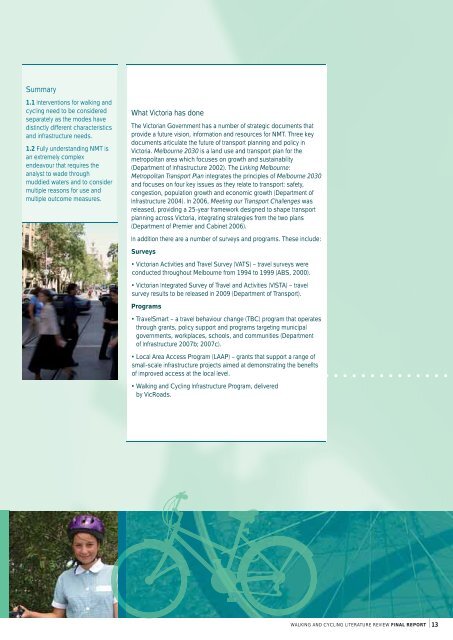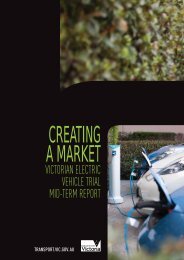Walking and Cycling International Literature Review - Department of ...
Walking and Cycling International Literature Review - Department of ...
Walking and Cycling International Literature Review - Department of ...
Create successful ePaper yourself
Turn your PDF publications into a flip-book with our unique Google optimized e-Paper software.
Summary<br />
1.1 Interventions for walking <strong>and</strong><br />
cycling need to be considered<br />
separately as the modes have<br />
distinctly different characteristics<br />
<strong>and</strong> infrastructure needs.<br />
1.2 Fully underst<strong>and</strong>ing NMT is<br />
an extremely complex<br />
endeavour that requires the<br />
analyst to wade through<br />
muddied waters <strong>and</strong> to consider<br />
multiple reasons for use <strong>and</strong><br />
multiple outcome measures.<br />
What Victoria has done<br />
The Victorian Government has a number <strong>of</strong> strategic documents that<br />
provide a future vision, information <strong>and</strong> resources for NMT. Three key<br />
documents articulate the future <strong>of</strong> transport planning <strong>and</strong> policy in<br />
Victoria. Melbourne 2030 is a l<strong>and</strong> use <strong>and</strong> transport plan for the<br />
metropolitan area which focuses on growth <strong>and</strong> sustainability<br />
(<strong>Department</strong> <strong>of</strong> Infrastructure 2002). The Linking Melbourne:<br />
Metropolitan Transport Plan integrates the principles <strong>of</strong> Melbourne 2030<br />
<strong>and</strong> focuses on four key issues as they relate to transport: safety,<br />
congestion, population growth <strong>and</strong> economic growth (<strong>Department</strong> <strong>of</strong><br />
Infrastructure 2004). In 2006, Meeting our Transport Challenges was<br />
released, providing a 25-year framework designed to shape transport<br />
planning across Victoria, integrating strategies from the two plans<br />
(<strong>Department</strong> <strong>of</strong> Premier <strong>and</strong> Cabinet 2006).<br />
In addition there are a number <strong>of</strong> surveys <strong>and</strong> programs. These include:<br />
Surveys<br />
• Victorian Activities <strong>and</strong> Travel Survey (VATS) – travel surveys were<br />
conducted throughout Melbourne from 1994 to 1999 (ABS, 2000).<br />
• Victorian Integrated Survey <strong>of</strong> Travel <strong>and</strong> Activities (VISTA) – travel<br />
survey results to be released in 2009 (<strong>Department</strong> <strong>of</strong> Transport).<br />
Programs<br />
• TravelSmart – a travel behaviour change (TBC) program that operates<br />
through grants, policy support <strong>and</strong> programs targeting municipal<br />
governments, workplaces, schools, <strong>and</strong> communities (<strong>Department</strong><br />
<strong>of</strong> Infrastructure 2007b; 2007c).<br />
• Local Area Access Program (LAAP) – grants that support a range <strong>of</strong><br />
small-scale infrastructure projects aimed at demonstrating the benefi ts<br />
<strong>of</strong> improved access at the local level.<br />
• <strong>Walking</strong> <strong>and</strong> <strong>Cycling</strong> Infrastructure Program, delivered<br />
by VicRoads.<br />
WALKING AND CYCLING LITERATURE REVIEW FINAL REPORT 13

















